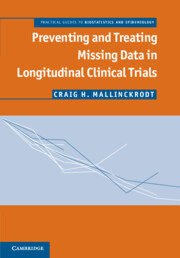Book contents
- Frontmatter
- Contents
- List of Figures
- List of Tables
- Acknowledgments
- Preface
- Part I Background and Setting
- Part II Preventing Missing Data
- Part III Analytic Considerations
- Part IV Analyses and The Analytic Road Map
- 9 Analyses of Incomplete Data
- 10 MNAR Analyses
- 11 Choosing Primary Estimands and Analyses
- 12 The Analytic Road Map
- 13 Analyzing Incomplete Categorical Data
- 14 Example
- 15 Putting Principles into Practice
- Bibliography
- Index
9 - Analyses of Incomplete Data
Published online by Cambridge University Press: 05 February 2013
- Frontmatter
- Contents
- List of Figures
- List of Tables
- Acknowledgments
- Preface
- Part I Background and Setting
- Part II Preventing Missing Data
- Part III Analytic Considerations
- Part IV Analyses and The Analytic Road Map
- 9 Analyses of Incomplete Data
- 10 MNAR Analyses
- 11 Choosing Primary Estimands and Analyses
- 12 The Analytic Road Map
- 13 Analyzing Incomplete Categorical Data
- 14 Example
- 15 Putting Principles into Practice
- Bibliography
- Index
Summary
Introduction
Describing an analysis requires specifying the method of estimation, the model (which parameters are to be estimated), and choice of data. Choice of data in this context refers to whether or not follow-up data are included, whether or not missing data are imputed, and whether or not observed data are weighted by the inverse probability of being missing.
In this chapter, methods, models, and choice of data are combined to illustrate some of the commonly used analyses for incomplete longitudinal clinical trial data. These analyses are illustrated using small, hypothetical data sets that allow insight into how the methods work when applied to incomplete data. Two data sets are used. The first is a data set with no missing values. The second data set is identical to the first, with the exception that 30% of the endpoint data are missing.
The complete data are listed in Table 9.1. Data are intended to mimic antidepressant clinical trials where symptom severity is based on the Hamilton Depression Rating Scale (Hamilton, 1960). Baseline values are the actual symptom severity scores. Values at times 1, 2, and 3 are changes from baseline, with negative values indicating improvement. Values underlined and in bold are values that were deleted to create the incomplete data set.
- Type
- Chapter
- Information
- Preventing and Treating Missing Data in Longitudinal Clinical TrialsA Practical Guide, pp. 73 - 90Publisher: Cambridge University PressPrint publication year: 2013



